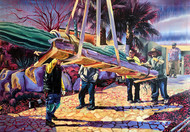Art in Isolation: Rex Southwick
Posted by Cass Art on 30th May 2020
These are very strange and uncertain times for us all. The idea of the unknown is a difficult place to be in. This period in our lives will be the utmost test of our mental strength and courage. It’s really no surprise that in times of unease we turn our attention to fictional stories which in most cases have a relative comfort resolution to distract us from what’s going on outside and in some cases inside our front doors. In this series Art in Isolation each week we want to speak to different artists and creatives from around the art world to see what they’re doing during this period of self-isolation whether they’re making, reflecting or simply taking a break. To see what this time means to them personally and professionally. Also, what art means to them, something that shouldn’t be forgotten. This week we speak to artist Rex Southwick.
Rex Southwick’s paintings verge on the self-referential: they are concerned with the often gritty process of creating something deemed beautiful. We speak to Rex about his journey as an artist, his work and what he’s up to in self-isolation.
Hi Rex, thanks so much for taking some to chat to us. Firstly, what inspired you to become an artist?
I’m not sure anything did, I think it was always something that I was better at than other things so like all things you enjoy doing it receives far more time and attention. I have always found visual things far easier to absorb and so creating them seemed like a natural progression and a good way to represent my interests. I think the crux of any artists practice is an unhealthy obsession with a making physical things out of ideas and avenues of interest that are usually overlooked or showcased in a format that doesn’t interest people or stick with them.
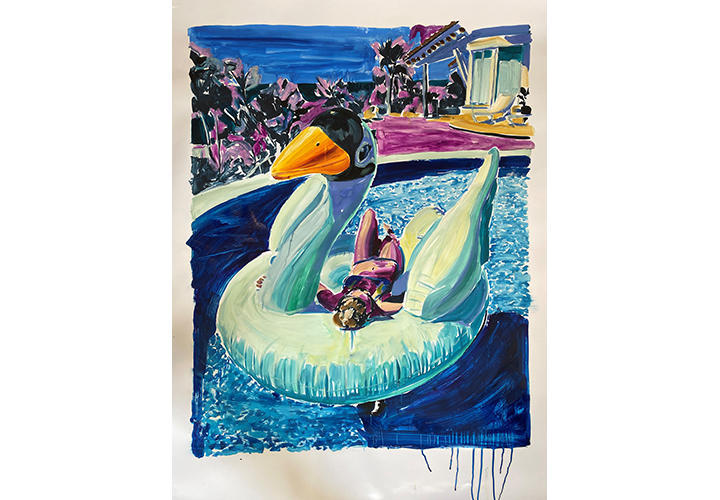
Your paintings have such a highly charged saturated aesthetic to them, could you talk to us about the process of production and how you achieve this?
So many years ago I started playing with different coloured grounds for paintings, eventually after much trial and error I stumbled on a bright pink that is now the base of ever painting I make. The colour stuck as it does well at tying the painting together, it also prevents colours that I avoid from appearing. I use allot of opaque pigments and this pink ground allows them to work in ways they can’t if they were just applied to a plain white surface.
I don't consider my paintings bright, I think when I start every painting I start enhancing every trace of a colour that could be there, soon this enhancement of every colour ends up with the work taking on a highly saturated appearance. I try to maintain the colours vibrancy by not re working the paintings once an area of the pink ground is covered I move on, any essential changes are done at the very end when there is no pink ground base visible and the full composition is done.
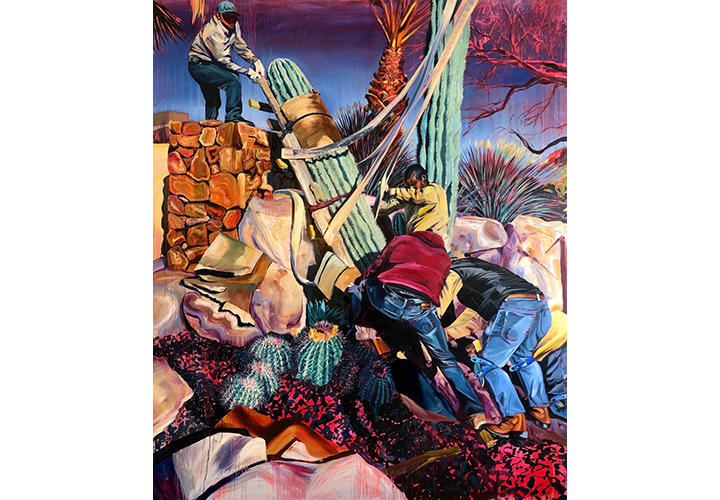
I’ve heard your work described as manifesting the undercurrents in our desire for safety luxury and the domestic dream. Can you tell us about your work?
So much of the work focuses on idealised modernist houses, the once modernist homes of Palm Springs and California have become the standard design template in the ideal ‘Luxury lifestyle’. Architecture has always had the ability to change how we feel and so in due course change how we act in a certain space. My work explores these spaces being build and make us look at these domestic spaces in a new light. The paintings always show domestic or construction staff with a backdrop of private homes, the idea being to show them in a new way, for the owners or developers of these homes these people are invisible, for the often immigrant labourers these follies of an alien lifestyle must seem utterly stupendous.
Recently I have been collaborating with the Tucson cactus society in Arizona, they rescue ancient cactuses for development and sell them at auction to developers and landscape designers, I track down some of the cactuses sold and paint them in their new homes, far removed from the scrub of Arizona.
The idea behind these works is that they show a deep rooted irony in digging up these plants to clear space for luxury homes, only to eventually and expensively reinstate them in geographically the same situation but representing something quite different. Does the planting of mature plants in domestic settings subversively reassure us and convince us of a reassuring form of permanence to the environments we make?
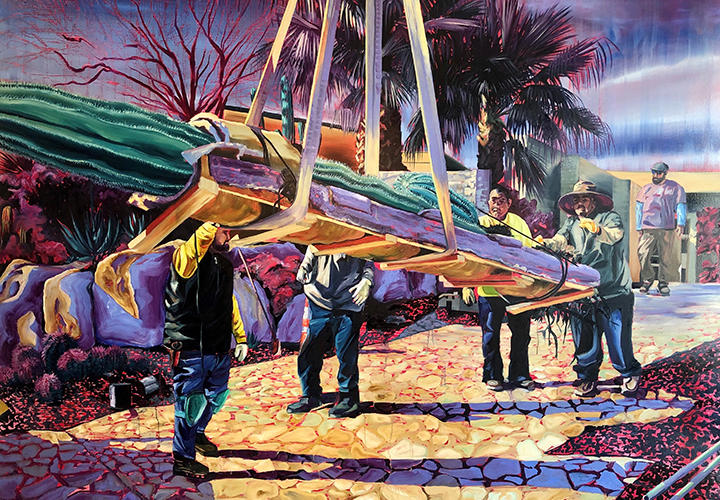
What are you making during this period of self-isolation?
Come to think of it I’ve been making art in isolation for a couple of years now but I suppose the difference being once a job was done down time was going/doing something but now with that removed it’s difficult to get into a productive routine - quarantine is a fantastic excuse to do noting... But I have been painting!
I was supposed to have a solo show at Unit London in May but due to Covid-19 the show is being pushed back all the time. (Hopefully it will open early July) So I have been working on some large paintings, the largest to date. I have also been playing around with painting on gloss papers and scaling up painting studies so that they can be shown alongside my paintings at Unit.
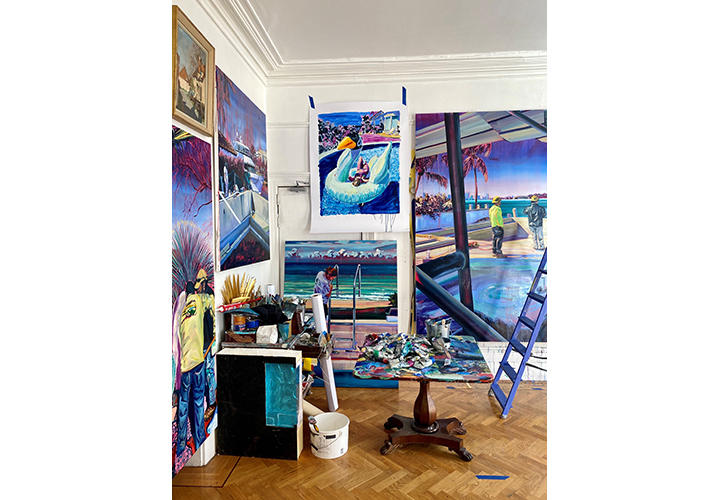
Why is this time so important for your practice?
I think we have forgotten how important it is to be ‘bored’ boredom is a luxury in today’s world. My boredom is manifested in scrolling through eBay, I’ve purchased allot of new materials. I’ve been buying Silicons and expanding foams which I’m adding to oil paint to just have fun with I guess. I’ve always maintained if you’re not having fun making something it’s going to make you resent it so best to throw it off a roof and start something that keeps your interest and the life in your practice.
Besides trying out new materials and throwing things off of the roof, this past month or so I’ve been reaching out to new people at the source of my practice. Something I don’t think I would have done so persistently without Covid, as I would have been in panic stations with a show coming up. Recently I started collaborating with the Tucson cactus society, who’s mission is to salvage and save ancient cactuses from development sites.I was already painting the moving and planting of these colossal plants before I stumbled across the society, previously collaborating with developers and construction companies. Previously using the cactuses to highlight the transition of idols from religious ones to fundamentally monetary ones encapsulates in 21st century domestic ideals. My last series of paintings used swimming pools as a motif for this sought after ideal.
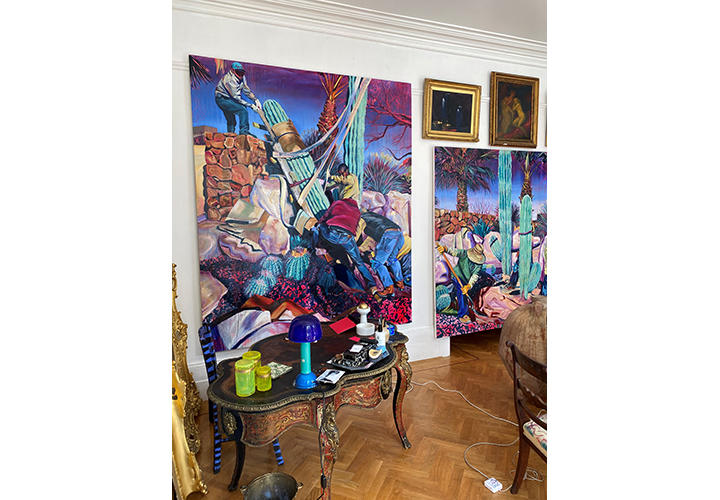
These once futuristic looking houses of the mid-century have now become the standard style of backdrop for people to live out their ideal lifestyle. I have always found it interesting how our surroundings affect behaviour and perhaps in turn how we think? I suppose this is especially relevant now we all find ourselves stuck in our homes. So as a development from painting the construction of these houses i am now looking at the idea of ‘domestic landscape’ and why we go to these lengths to move huge plants for purposes of creating an environment.
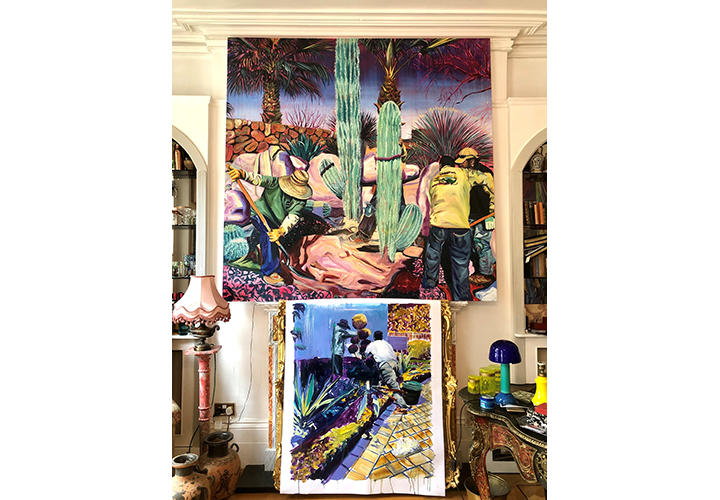
Finally, a question I think is always important to ask, why art is important to you?
Because my art are my interests transposed into something visual. I love making things and collecting ‘stuff’ so being an artist brings both of these together, and puts you in touch with the history and the future of making. Arts wide margin for subjectivity gives it an appeal to anyone, as how you encounter or think about a piece of art can’t be wrong (can be controversial). For me there will always be a huge appeal to objects that demand an emotional response, either because of how they look or what they represent. Art provides these objects and provides context to the time they were made.
See more of Rex's work here.
Feeling Inspired?
Shop online for everything you'll need. Don't forget to hashtag #cassart on social media to show us your creations.

